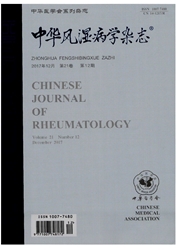

 中文摘要:
中文摘要:
目的研究Ⅰ型干扰素受体基因内部的单核苷酸多态性(SNP)与中国人群狼疮肾炎发病的相关性。方法选择IFNAR1和IFNAR2内部的14个SNP标记在200个核心家系,537例系统性红斑狼疮(SLE)患者(203例狼疮肾炎患者和334例狼疮非肾炎患者)和252名正常人中进行等位基因分型,以Haploview软件分析SNP分布情况,并用FBAT软件做TDT分析。结果发现中国汉族人群中①IFNAR1-SNP rs2243594等位基因频率(G)在SLE患者(29.0%)和正常人(21.2%)中差异有统计学意义(P〈0.01)。AA基因型的频率在SLE患者(50.3%)低于正常对照组(61.2%,P〈0.05)。②IFNAR1-SNP rs2243594等位基因频率(G)在狼疮肾炎患者(35.5%)和正常人(21.2%)两组对象的差异有统计学意义(P〈0.01)。AA基因型的频率在狼疮肾炎患者(39.1%)低于正常对照组(61.2%,P〈0.01)。③IFNAR1含有rs2243594G等位基因的单倍型频率在SLE肾炎患者与正常人差异有统计学意义(P〈0.05)。④rs2243594G等位基因在肾炎家系中有优势传递。结论IFNAR基因的变异可能在狼疮肾炎发病中发挥作用。
 英文摘要:
英文摘要:
Objective To observe whether single nucleotide polymorphisms (SNPs) within the type Ⅰ interferon receptor (IFNAR) gene are associated with lupus nephritis (LN) susceptibility in Chinese population. Methods Thirteen SNPs located in IFNAR gene with high heterozygosity were chosen for genotyping on 200 nuclear families, 537 systemic lupus erythematosus (SLE) patients, including 203 LN patient and non-LN patient, and 252 normal controls using taqman MGB allelic discrimination method. Data were analysed by SDS 2.1 software. Haplotypes and their frequencies were constructed and estimated by Haploview and FBAT program. Case-control study were performed between the SLE, LN, non-LN groups and normal control group. Results ①The frequency of SNP rs2243594 G allele was 29.0% in the SLE patients, significantly higher than that in the control (P〈0.01). The AA genotype frequency of the SLE patients was 50.3%, significantly lower than that of the control (P〈0.05). ②The SNP rs2243594 G allele frequency of the SLE LN group was 35.5%, significantly higher than that of the control (P〈0.01). The AA genotype frequency of the LN patients was 39.1%, significantly lower than that of the control (61.2%) (P〈0.01). ③The frequencies of haplotypes containing rs2243594 G allele were different between SLE nephritis patients and normal control group (P〈0.05). ④SNP rs2243594 G allele were overtransmitted in nephritis families. Conclusion SNP rs2243594 and some haplotypes containing SNP rs2243594 within IFNAR1 are significantly associated with LN susceptibility. Genetic variation of the IFNAR gene are involved in the pathogenesis of LN.
 同期刊论文项目
同期刊论文项目
 同项目期刊论文
同项目期刊论文
 期刊信息
期刊信息
